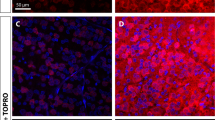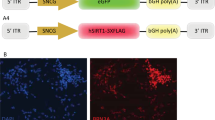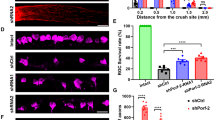Abstract
Lack of axon growth ability in the central nervous system poses a major barrier to achieving functional connectivity after injury. Thus, a non-transgenic regenerative approach to reinnervating targets has important implications in clinical and research settings. Previous studies using knockout (KO) mice have demonstrated long-distance axon regeneration. Using an optic nerve injury model, here we evaluate the efficacy of viral, RNA interference (RNAi) and pharmacological approaches that target the phosphatase and tensin homolog (PTEN) and signal transducer and activator of transcription-3 pathways to improve long-distance axon regeneration in wild-type mice. Our data show that adeno-associated virus (AAV) expressing short hairpin RNA (shRNA) against PTEN (shPTEN) enhances retinal ganglion cell axon regeneration after crush injury. However, compared with the previous data in PTEN KO mice, AAV-shRNA results in a lesser degree of regeneration, likely due to incomplete gene silencing inherent to RNAi. In comparison, an extensive enhancement in regeneration is seen when AAV-shPTEN is coupled to AAV encoding ciliary neurotrophic factor (CNTF) and to a cyclic adenosine monophosphate (cAMP) analog, allowing axons to travel long distances and reach their target. We apply whole-tissue imaging that facilitates three-dimensional visualization of single regenerating axons and document heterogeneous terminal patterns in the targets. This shows that some axonal populations generate extensive arbors and make synapses with the target neurons. Collectively, we show a combinatorial viral RNAi and pharmacological strategy that improves long-distance regeneration in wild-type animals and provide single fiber projection data that indicates a degree of preservation of target recognition.
This is a preview of subscription content, access via your institution
Access options
Subscribe to this journal
Receive 12 print issues and online access
$259.00 per year
only $21.58 per issue
Buy this article
- Purchase on Springer Link
- Instant access to full article PDF
Prices may be subject to local taxes which are calculated during checkout






Similar content being viewed by others
References
Park KK, Liu K, Hu Y, Smith PD, Wang C, Cai B et al. Promoting axon regeneration in the adult CNS by modulation of the PTEN/mTOR pathway. Science 2008; 322: 963–966.
Smith PD, Sun F, Park KK, Cai B, Wang C, Kuwako K et al. SOCS3 deletion promotes optic nerve regeneration in vivo. Neuron 2009; 64: 617–623.
Sun F, Park KK, Belin S, Wang D, Lu T, Chen G et al. Sustained axon regeneration induced by co-deletion of PTEN and SOCS3. Nature 2011; 480: 372–375.
de Lima S, Koriyama Y, Kurimoto T, Oliveira JT, Yin Y, Li Y et al. Full-length axon regeneration in the adult mouse optic nerve and partial recovery of simple visual behaviors. Proc Natl Acad Sci USA 2012; 109: 9149–9154.
Kotterman MA, Schaffer DV . Engineering adeno-associated viruses for clinical gene therapy. Nat Rev Genet 2014; 15: 445–451.
Alsina B, Vu T, Cohen-Cory S . Visualizing synapse formation in arborizing optic axons in vivo: dynamics and modulation by BDNF. Nat Neurosci 2001; 4: 1093–1101.
Robles E, Laurell E, Baier H . The retinal projectome reveals brain-area-specific visual representations generated by ganglion cell diversity. Curr Biol 2014; 24: 2085–2096.
Chung KH, Hart CC, Al-Bassam S, Avery A, Taylor J, Patel PD et al. Polycistronic RNA polymerase II expression vectors for RNA interference based on BIC/miR-155. Nucleic Acids Res 2006; 34: e53.
Zukor K, Belin S, Wang C, Keelan N, Wang X, He Z . Short hairpin RNA against PTEN enhances regenerative growth of corticospinal tract axons after spinal cord injury. J Neurosci 2013; 33: 15350–15361.
Luikart BW, Schnell E, Washburn EK, Bensen AL, Tovar KR, Westbrook GL . Pten knockdown in vivo increases excitatory drive onto dentate granule cells. J Neurosci 2011; 31: 4345–4354.
Hellstrom M, Harvey AR . Retinal ganglion cell gene therapy and visual system repair. Curr Gene Ther 2011; 11: 116–131.
Leaver SG, Cui Q, Bernard O, Harvey AR . Cooperative effects of bcl-2 and AAV-mediated expression of CNTF on retinal ganglion cell survival and axonal regeneration in adult transgenic mice. Eur J Neurosci 2006; 24: 3323–3332.
Leaver SG, Cui Q, Plant GW, Arulpragasam A, Hisheh S, Verhaagen J et al. AAV-mediated expression of CNTF promotes long-term survival and regeneration of adult rat retinal ganglion cells. Gene Ther 2006; 13: 1328–1341.
Pernet V, Joly S, Dalkara D, Jordi N, Schwarz O, Christ F et al. Long-distance axonal regeneration induced by CNTF gene transfer is impaired by axonal misguidance in the injured adult optic nerve. Neurobiol Dis 2013; 51: 202–213.
Pernet V, Joly S, Jordi N, Dalkara D, Guzik-Kornacka A, Flannery JG et al. Misguidance and modulation of axonal regeneration by Stat3 and Rho/ROCK signaling in the transparent optic nerve. Cell Death Dis 2013; 4: e734.
Muller A, Hauk TG, Leibinger M, Marienfeld R, Fischer D . Exogenous CNTF stimulates axon regeneration of retinal ganglion cells partially via endogenous CNTF. Mol Cell Neurosci 2009; 41: 233–246.
Park K, Luo JM, Hisheh S, Harvey AR, Cui Q . Cellular mechanisms associated with spontaneous and ciliary neurotrophic factor-cAMP-induced survival and axonal regeneration of adult retinal ganglion cells. J Neurosci 2004; 24: 10806–10815.
Moore DL, Blackmore MG, Hu Y, Kaestner KH, Bixby JL, Lemmon VP et al. KLF family members regulate intrinsic axon regeneration ability. Science 2009; 326: 298–301.
Hellstrom M, Pollett MA, Harvey AR . Post-injury delivery of rAAV2-CNTF combined with short-term pharmacotherapy is neuroprotective and promotes extensive axonal regeneration after optic nerve trauma. J Neurotrauma 2011; 28: 2475–2483.
Hellstrom M, Harvey AR . Cyclic AMP and the regeneration of retinal ganglion cell axons. Int J Biochem Cell Biol 2014; 56: 66–73.
Luo X, Yungher B, Park KK . Application of tissue clearing and light sheet fluorescence microscopy to assess optic nerve regeneration in unsectioned tissues. Methods Mol Biol 2014; 1162: 209–217.
Luo X, Salgueiro Y, Beckerman SR, Lemmon VP, Tsoulfas P, Park KK . Three-dimensional evaluation of retinal ganglion cell axon regeneration and pathfinding in whole mouse tissue after injury. Exp Neurol 2013; 247: 653–662.
Pernet V, Schwab ME . Lost in the jungle: new hurdles for optic nerve axon regeneration. Trends Neurosci 2014; 37: 381–387.
Louis GW, Leinninger GM, Rhodes CJ, Myers MG Jr . Direct innervation and modulation of orexin neurons by lateral hypothalamic LepRb neurons. J Neurosci 2010; 30: 11278–11287.
Kurimoto T, Yin Y, Omura K, Gilbert HY, Kim D, Cen LP et al. Long-distance axon regeneration in the mature optic nerve: contributions of oncomodulin, cAMP, and pten gene deletion. J Neurosci 2010; 30: 15654–15663.
Lewandowski G, Steward O . AAVshRNA-mediated suppression of PTEN in adult rats in combination with salmon fibrin administration enables regenerative growth of corticospinal axons and enhances recovery of voluntary motor function after cervical spinal cord injury. J Neurosci 2014; 34: 9951–9962.
Ohtake Y, Park D, Abdul-Muneer PM, Li H, Xu B, Sharma K et al. The effect of systemic PTEN antagonist peptides on axon growth and functional recovery after spinal cord injury. Biomaterials 2014; 35: 4610–4626.
Christie KJ, Webber CA, Martinez JA, Singh B, Zochodne DW . PTEN inhibition to facilitate intrinsic regenerative outgrowth of adult peripheral axons. J Neurosci 2010; 30: 9306–9315.
Xu XM, Yoo MH, Carlson BA, Gladyshev VN, Hatfield DL . Simultaneous knockdown of the expression of two genes using multiple shRNAs and subsequent knock-in of their expression. Nat Protoc 2009; 4: 1338–1348.
Fraser MM, Bayazitov IT, Zakharenko SS, Baker SJ . Phosphatase and tensin homolog, deleted on chromosome 10 deficiency in brain causes defects in synaptic structure, transmission and plasticity, and myelination abnormalities. Neuroscience 2008; 151: 476–488.
Hellstrom M, Muhling J, Ehlert EM, Verhaagen J, Pollett MA, Hu Y et al. Negative impact of rAAV2 mediated expression of SOCS3 on the regeneration of adult retinal ganglion cell axons. Mol Cell Neurosci 2011; 46: 507–515.
Gao Y, Deng K, Hou J, Bryson JB, Barco A, Nikulina E et al. Activated CREB is sufficient to overcome inhibitors in myelin and promote spinal axon regeneration in vivo. Neuron 2004; 44: 609–621.
Park KK, Hu Y, Muhling J, Pollett MA, Dallimore EJ, Turnley AM et al. Cytokine-induced SOCS expression is inhibited by cAMP analogue: impact on regeneration in injured retina. Mol Cell Neurosci 2009; 41: 313–324.
Wyatt C, Ebert A, Reimer MM, Rasband K, Hardy M, Chien CB et al. Analysis of the astray/robo2 zebrafish mutant reveals that degenerating tracts do not provide strong guidance cues for regenerating optic axons. J Neurosci 2010; 30: 13838–13849.
Osterhout JA, El-Danaf RN, Nguyen PL, Huberman AD . Birthdate and outgrowth timing predict cellular mechanisms of axon target matching in the developing visual pathway. Cell Rep 2014; 8: 1006–1017.
McFarlane S, McNeill L, Holt CE . FGF signaling and target recognition in the developing Xenopus visual system. Neuron 1995; 15: 1017–1028.
Cohen-Cory S, Fraser SE . Effects of brain-derived neurotrophic factor on optic axon branching and remodelling in vivo. Nature 1995; 378: 192–196.
Aviles-Trigueros M, Sauve Y, Lund RD, Vidal-Sanz M . Selective innervation of retinorecipient brainstem nuclei by retinal ganglion cell axons regenerating through peripheral nerve grafts in adult rats. J Neurosci 2000; 20: 361–374.
Vidal-Sanz M, Aviles-Trigueros M, Whiteley SJ, Sauve Y, Lund RD . Reinnervation of the pretectum in adult rats by regenerated retinal ganglion cell axons: anatomical and functional studies. Prog Brain Res 2002; 137: 443–452.
Wizenmann A, Bahr M . Growth characteristics of ganglion cell axons in the developing and regenerating retino-tectal projection of the rat. Cell Tissue Res 1997; 290: 395–403.
Sauve Y, Sawai H, Rasminsky M . Topological specificity in reinnervation of the superior colliculus by regenerated retinal ganglion cell axons in adult hamsters. J Neurosci 2001; 21: 951–960.
Carter DA, Bray GM, Aguayo AJ . Regenerated retinal ganglion cell axons form normal numbers of boutons but fail to expand their arbors in the superior colliculus. J Neurocytol 1998; 27: 187–196.
Sauve Y, Sawai H, Rasminsky M . Functional synaptic connections made by regenerated retinal ganglion cell axons in the superior colliculus of adult hamsters. J Neurosci 1995; 15: 665–675.
Carter DA, Bray GM, Aguayo AJ . Regenerated retinal ganglion cell axons can form well-differentiated synapses in the superior colliculus of adult hamsters. J Neurosci 1989; 9: 4042–4050.
Li S, He Q, Wang H, Tang X, Ho KW, Gao X et al. Injured adult retinal axons with Pten and Socs3 co-deletion reform active synapses with suprachiasmatic neurons. Neurobiol Dis 2014; 73C: 366–376.
Hattar S, Kumar M, Park A, Tong P, Tung J, Yau KW et al. Central projections of melanopsin-expressing retinal ganglion cells in the mouse. J Comp Neurol 2006; 497: 326–349.
Ui-Tei K, Naito Y, Takahashi F, Haraguchi T, Ohki-Hamazaki H, Juni A et al. Guidelines for the selection of highly effective siRNA sequences for mammalian and chick RNA interference. Nucleic Acids Res 2004; 32: 936–948.
Blackmore MG, Wang Z, Lerch JK, Motti D, Zhang YP, Shields CB et al. Kruppel-like Factor 7 engineered for transcriptional activation promotes axon regeneration in the adult corticospinal tract. Proc Natl Acad Sci USA 2012; 109: 7517–7522.
Erturk A, Mauch CP, Hellal F, Forstner F, Keck T, Becker K et al. Three-dimensional imaging of the unsectioned adult spinal cord to assess axon regeneration and glial responses after injury. Nat Med 2012; 18: 166–171.
Acknowledgements
This work was supported by grants from US Army W81XWH-05-1-0061 (KKP), W81XWH-12-1-0319 (KKP), NEI 1R01EY022961-01 (KKP), Ziegler Foundation (KKP), Pew Charitable Trust (KKP), Craig H. Neilsen Foundation (KKP) and the Buoniconti Fund (KKP). We thank Imaging, and Viral Vector Core at the Miami Project to Cure Paralysis, Dr David Turner for SIBR vector, Dr Vance Lemmon and Dr John Bixby for guidance with shRNA vector, Drs William Hauswirth and Vince Chiodo for initial testing with AAV-CNTF, and Dr Bryan Luikart for shPTEN plasmid.
Author information
Authors and Affiliations
Corresponding author
Ethics declarations
Competing interests
The authors declare no conflict of interest
Rights and permissions
About this article
Cite this article
Yungher, B., Luo, X., Salgueiro, Y. et al. Viral vector-based improvement of optic nerve regeneration: characterization of individual axons’ growth patterns and synaptogenesis in a visual target. Gene Ther 22, 811–821 (2015). https://doi.org/10.1038/gt.2015.51
Received:
Revised:
Accepted:
Published:
Issue Date:
DOI: https://doi.org/10.1038/gt.2015.51
This article is cited by
-
Transcriptional repression of PTEN in neural cells using CRISPR/dCas9 epigenetic editing
Scientific Reports (2020)
-
Factors governing the transduction efficiency of adeno-associated virus in the retinal ganglion cells following intravitreal injection
Gene Therapy (2019)
-
The extent of extra-axonal tissue damage determines the levels of CSPG upregulation and the success of experimental axon regeneration in the CNS
Scientific Reports (2018)
-
Complementary research models and methods to study axonal regeneration in the vertebrate retinofugal system
Brain Structure and Function (2018)
-
Boosting Central Nervous System Axon Regeneration by Circumventing Limitations of Natural Cytokine Signaling
Molecular Therapy (2016)



